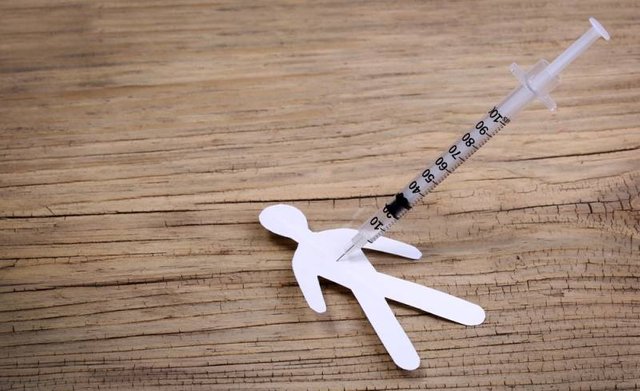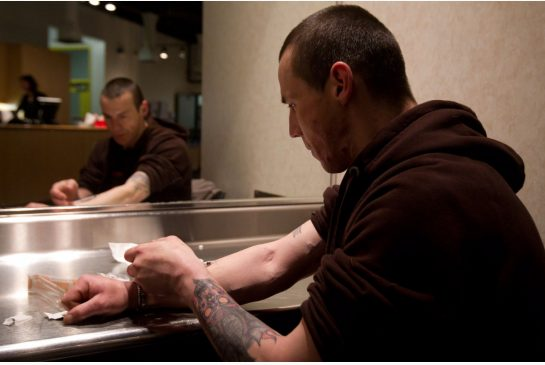Heroin Injection Clinics Save Lives
According to the National Institute on Drug Abuse (NIH), the number of overdose deaths from opiates has skyrocketed in the last 15 years. Between 2001 and 2014, overdose deaths from heroin went from 2,000 to roughly 12,000: a 6-fold increase. Opioid pain relievers (such as morphine and oxycontin) accounted for 19,000 overdose deaths in 2014 as opposed to the 5,500 deaths in 2001. And now we're in 2016.

image from thefix.com
Mayor Svante Myrick, of Ithaca, New York, saw this trend, so he decided to open the very first heroin injection center in the United States. His goal with the clinic is to help prevent drug overdose, reduce the spread of infectious diseases, reduce drug-related crimes, and promote addiction treatment.
Injection clinics offer regulated, gradually decreasing doses of heroin to individuals in a sterile, safe, monitored environment with medical staff on hand. They also generally provide social services and psychological treatment to individuals who choose. The goal is to wean addicts off the drug and help them adjust into society again.
Mayor Myrick believes the criminal justice system in America has failed, where drug treatment programs and drug injection centers have succeeded. The first “supervised injection” facility to open in North America was in Vancouver, Canada in 2003, called Insite. Insite touts full support from the World Health Organization and the Canadian Public Health Association because of their success in disease prevention, crime reduction, and addiction recovery.
The injection clinic brags a 70% addiction recovery rate among even the most hardened addicts, which blows the best anti-drug campaigns and traditional rehab programs out of the water. Unfortunately, protestors and activists against the clinic believed it was condoning drug use. Even the federal government sued the clinic, arguing that Insite fostered addiction and promoted crime — despite all the evidence to the contrary. But the Supreme Court saw the recovery statistics from the injection clinic and ruled against the federal government for trying to shut it down.

image from rockrivertimes.com
In 2009, Time Magazine did an excellent article on this subject. Clinics in Great Britain (the second country in Europe to introduce an injection clinic) actually offered heroin as a regulated medication for hardened, long-time addicts who were not able to respond to detox and methadone alone. Britain did a 4-year trial involving addicts in London, Darlington and Brighton, in an effort to wean addicts off the heroin. Participants were divided into three groups.
Group 1 was given heroin. Groups 2 and 3 were given intravenous methadone and oral methadone. All three groups received counseling and social services. All three groups improved physically and mentally. But Group 1 did the best by far. After only 6 months, three-quarters of this study group had largely stopped taking heroin, and the number of crimes had also decreased by 70% — astounding results after such a short period of time.
And statistics improve even more over time. Britain’s clinics boast an 85% recovery rate among addicts who attend their clinic. Often they are prescribed low doses of morphine and methadone to keep the heroin craving at bay. But they get their lives back.
Time Magazine talks about Sarah, a participant who had a 20-year heroin habit and countless failed attempts at quitting her addiction. Sarah states that most of her time was chaotically spent either “doing drugs”, or “looking for money to buy drugs”. When she came to the clinic, she found huge progress within only a few short months.
It was the right decision, and it was my decision, so I feel quite stable in my recovery
Like many of the clinic’s visitors, Sarah received help with housing and with her depression, and she even served as a mentor for inmates getting out of prison.
Time states that within the first year of the trial, Sarah had reduced her injections from twice a day to once, and she recently quit heroin altogether in favor of a mixture of morphine and methadone. She hopes to be off the drugs soon, crediting her resolve to the program’s nonjudgmental attitude.
Another study from Arizona State University examined traditional drug treatment and recidivism. The subjects were a narrower group than found at the injection clinics. Only non-violent, first-time offenders participated in this program designed to divert individuals from jail.

Jail time, or treatment time? (image from www.phoenixhouse.org)
The program was successful. Only 22% of the individuals who completed the drug treatment program reoffended within 5 years, compared to 52% of the individuals who had opted for jail time instead and reoffended once out of jail. There is a reason most states offer drug treatment programs instead of jail time--the recidivism rate is much lower.
But remember, this study only included non-violent, first-time offenders. What about the hardened, long-time addicts who have been drug addicts committing crimes for decades? Is there any hope for them? For their families? For our society? The world is beginning to see addicts in a new light: not strictly as criminals, but as patients in need of serious treatment. Canada’s Insite actually refers to visiting addicts as “clients.” Ensuring safe and sanitary doses of drugs is only part of the picture.
Insite’s bigger goal is to help clients “develop trusting relationships with our health care and social workers, making them more likely to pursue withdrawal management (detox), addiction counseling and other addiction treatment services.”

client taking "safe" dose of heroin at Insite Clinic (image from wskgnews.org)
Are there still overdoses at Insite? Yes. Out of the 193,764 visits to the injection room in 2012, there were 497 that resulted in an overdose — less than 3%. But doctors and staff intervened immediately with appropriate medical attention. Furthermore, the nurses are able to decrease patients’ dosages over time, both preventing overdose and helping the individual to wean off of the drug entirely.
Are injection clinics sending the wrong message by persuading drug users to “shoot up safely! We’ll help you!” No. Clients who come to the clinics usually want to get OFF the drug. They don't want to overdose. They don’t want to get HIV. They don’t want to live in filth. They don’t want to be criminals. They don't want to throw their lives away. They want to be contributing members of society. They want their dreams back. This is why they come. But their bodies NEED the drug. Because of this clinic and clinics like it, addicts can confront and overcome their addictions and return to society as contributing members, and finally get their lives back.
Mayor Myrick might be onto something. Perhaps Ithaca is right to keep him on a second term.
original text: https://medium.com/@bjharding/heroin-nurses-give-safe-doses-to-addicts-a0266dcc97fc#.9ofjyfrb3
plagiarism
This is my original text. I pulled it from my account on Medium.com
If that is the case i apologize. Maybe you should edit the post on medium.com, adding that you will share it on steemit with the account "littlescibe" to prove it the next time. Happy blogging mate
Thanks for the tip.
It does save lives!